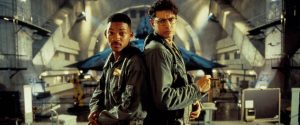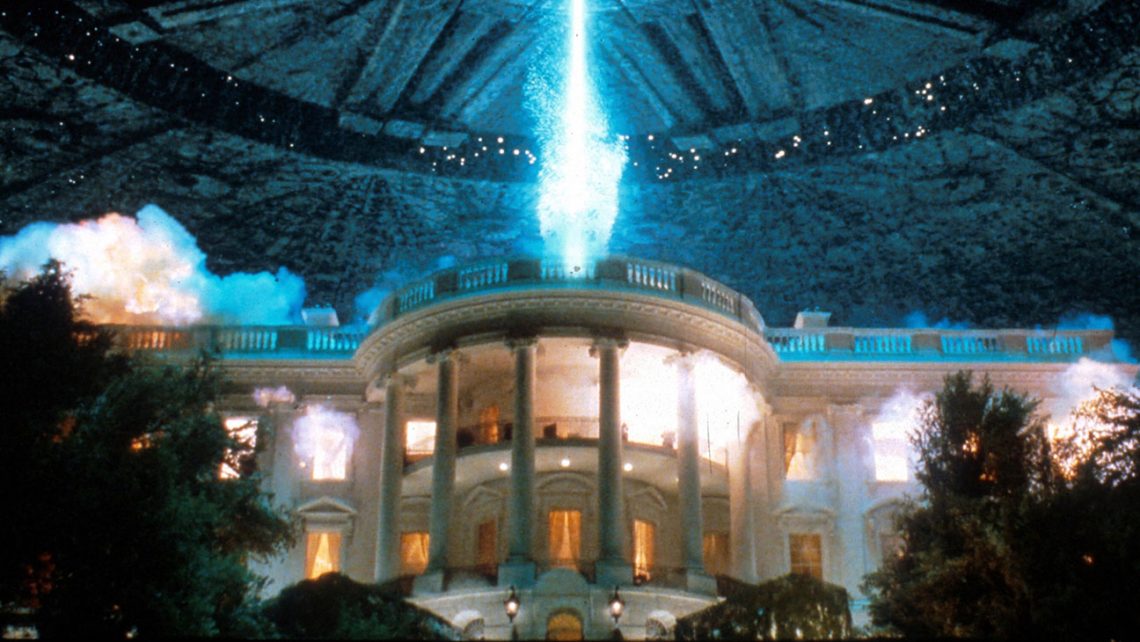Take a moment to rewatch the original cinematic trailer for the 1996 blockbuster film Independence Day.
It might look dated and clichéd by the standards of today’s trailers, but when it first appeared on cinema screens in 1995 it was a revelation. It had a huge impact and it changed how cinematic trailers are used to promote blockbuster films. Huge spectacles have been moved to early in shooting schedules so trailers could use these big action set pieces as soon as possible.
The image of the White House being destroyed by an alien spaceship really resonated with audiences in 1996. I do not believe this was political, I believe it was because cinema has the ability to convince us that we are small and the events we are seeing being played out are greater than we are. The image of the White House exploding was lodged in our collective imagination, it became iconic. Independence Day became a key link in the evolution of the city destroying disaster movie, leading to Volcano (1997), Armageddon, Deep Impact and Godzilla, all 1998. It was also a key development of the evolution of the cinematic spectacle, which is what film has been since Auguste and Louis Lumiere showed Train Pulling Into A Station to an audience in Paris in 1895.
Cinema has always been about the spectacle. We go to the cinema for the communal act of sharing a film and for the spectacle of seeing larger than life actions played out before us. Anyone who says otherwise has been watching too many Wes Anderson films and not enough David Lean. In many ways, the evolution of cinema has been the evolution of the spectacle. Stagecoach was a spectacle when it first exploded into cinemas in 1939. Colour was popularised so that cinema could use spectacle to compete against the emerging medium of television. Cinema’s most iconic genres, from the western to the musical, the historical epic, the action adventure or the science fiction film, have embraced the cinematic spectacle.
In many ways Independence Day was no different to Stagecoach, or Ben-Hur or Seven Brides for Seven Brothers. It sought to attract audiences to the cinema by offering them a spectacle that could not be missed and could not be found anywhere else. In 1996 the special effects of Independence Day were genuinely impressive. 20 years later, the sequel, Independence Day Resurgence, is not a significant step forwards in terms of cinematic spectacle. Special effects have incrementally improved over the last 20 years, but this film is not the revolution its predecessor was.
Independence Day Resurgence continues the plot of the original, but does not follow on from its real contribution to cinema, which was how it changed the spectacle of cinema. Independence Day Resurgence is another middle of the road summer blockbuster, empty of plot or character, lacking in visuals that surprise cinema audiences. It is little different from X-Men: Apocalypse, released a few weeks earlier. This film is not the spiritual successor to the original Independence Day.

The last film that really was a step forwards for cinema spectacle was James Cameron’s Avatar, which brought back 3D filmmaking and immersed the viewer into an entire world of its creation. Like the original Independence Day, Avatar is also an empty film, lacking likable characters and an engaging story. Both were pure spectacle, without anything else that gives cinema its magic.
Avatar was another step in the evolution of cinema spectacle following on from Independence Day. It is a history which takes in such cinematic classics as the original Matrix film and George Lucas’s ill-fated Star Wars prequel trilogy. Avatar was released seven years ago and nothing has surpassed it visually. Films have tried, both of Joss Whedon’s Avengers films and Zack Snyder’s Superman films have given us city destroying spectacles, but it all seems very passé and not nearly as exciting as when this variety of spectacle was fresh in 1996.
Have we reached the limit to what cinema can achieve in terms of spectacle? Films are getting more expensive to make and studios are becoming more risk averse, thus the cinematic spectacle is not evolving. This is one reason why people are turning away from cinema to newTV. Cinema has no novel spectacle and huge numbers of bland sequels, remakes and adaptations has put audiences off. These films do not have plot and characters that people care about, which newTV does offer. Due to this, audiences have been lured away and the defining artistic medium of the age has moved from cinema to television.
Is cinema destined to become TV’s flashier cousin? Slightly more expensive and more lavish, but otherwise little different. If filmmakers cannot find a way to wow audiences with the spectacle of cinema than I fear it will be so. When was the last time we were captivated by a trailer like we were captivated by the trailer for Independence Day in 1996? Cinema is not just spectacle, but spectacle is an important part of the appeal of cinema as a medium. There are still lots of spectacular films being released, but we have not seen a revolution in cinema spectacle for quite some time.


